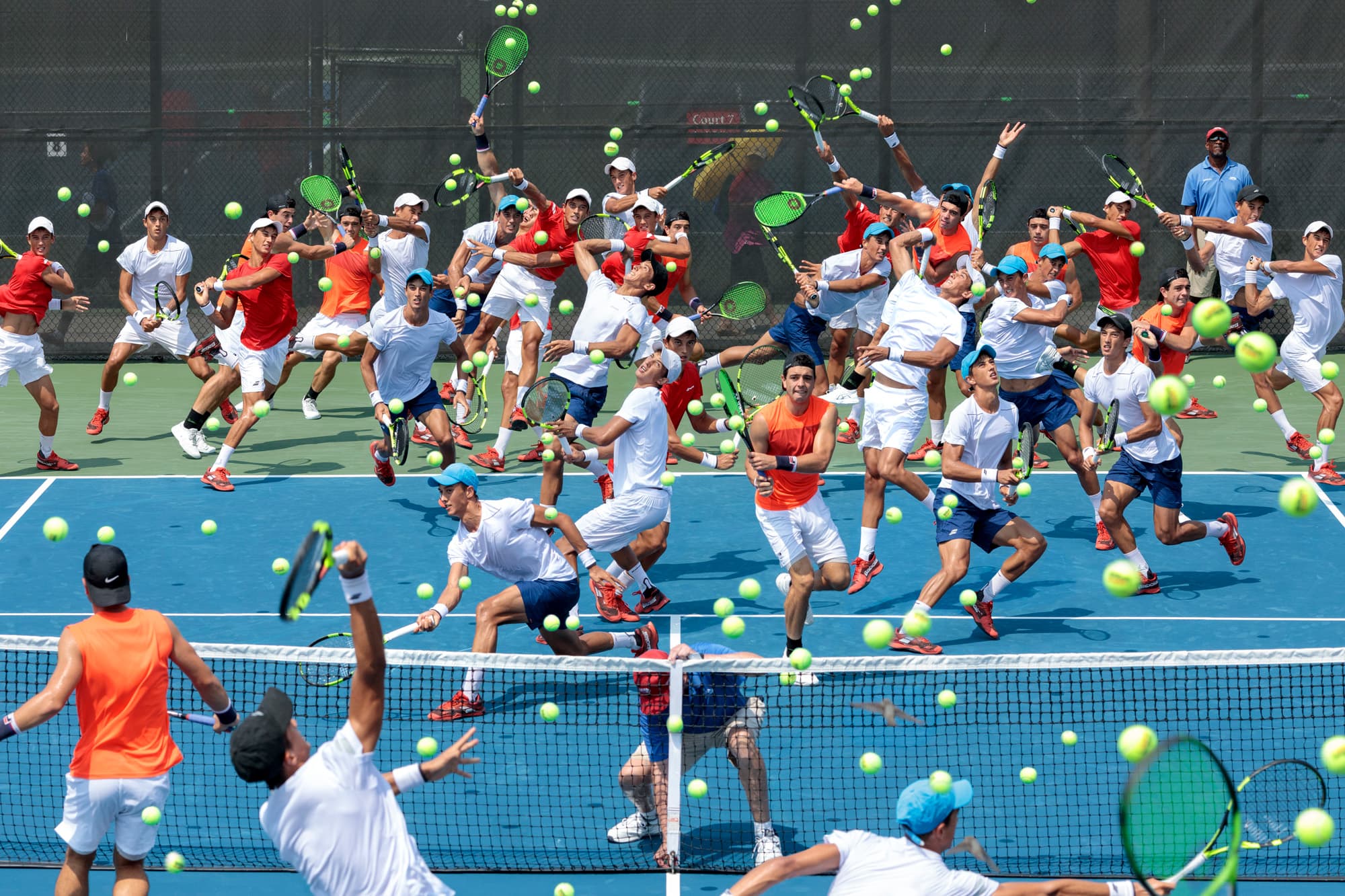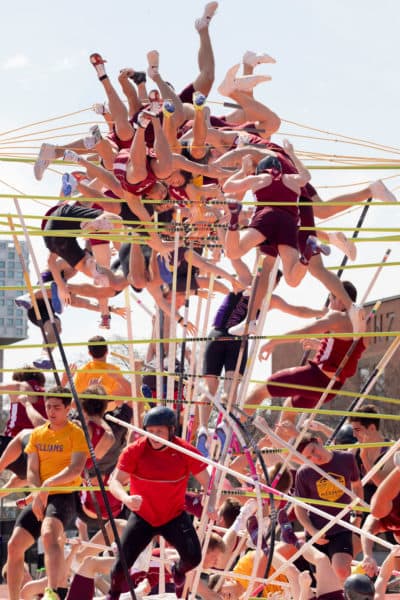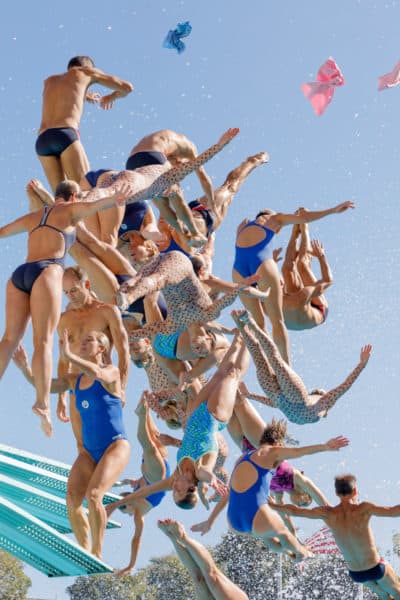Advertisement
In 'Crowded Fields,' Artist Pelle Cass Takes An Artful Approach To Sports Photography

Classic sports photography has its rules: A skillful photographer tells a story. That story revolves around winning and losing and how an athlete, with grit and determination, can overcome great odds to become a victor. Emotion is key. A good picture captures the agony of defeat or the thrill of victory, etched into pained or exuberant, sweaty faces.
Photographer Pelle Cass, in his latest group of photos, now on view in the show “Crowded Fields” at Abigail Ogilvy, doesn’t do any of those things.
“I was avoiding everything I knew about regular sports photography,” he says. “And it helped me a lot to avoid them. It made the pictures better.”

Cass presents an aestheticized, often whimsical view of sports, emphasizing pattern and pandemonium to tell a different story about the interconnected matrix of humankind. Time is compressed, thousands of shots are combined into one frame, and the viewer takes away not so much an individual story of triumph or loss, but something much more expansive about the human condition and our collective need for action, exertion, struggle and play.
“What I was really after is this chaotic, ecstatic feeling,” says Cass. “I play a lot of sports and what I like about it isn't so much the competition, but just moving around, and the chaos. The world really looks different when you're playing a sport and you're concentrating on the technique or the ball or whatever it is. The time slows down and compresses when you're playing sports in a way that is reminiscent of my pictures.”
There are 16 photographs on view in “Crowded Fields.” They are a tumult of arms, legs, poles, rackets and balls, and were taken mostly at sports events in and around Boston in the years immediately preceding the pandemic. We see a rainbow of rowers participating in the Head of the Charles Regatta; writhing, twisting bodies splashing about at a Harvard men’s water polo match; bright orange basketballs, dancing about a Dartmouth basketball court bereft of players; a convulsion of bodies and poles taken at a pole vault competition between MIT and Williams College. The compositions are arresting and usually fill an entire frame in riotous activity. None of these pictures tell a conventional story. Instead, time collapses in on itself.
Advertisement
“It's athletic nonsense,” says Cass. “But it's really rhythmic. And compositionally, it makes a lot of sense.”
Cass, now 66, has been taking photos his entire adult life. He’s explored a wide variety of subjects, ranging from his series “Selected People,” focusing on random pedestrians passing through intersections, sidewalks and parks, to photographed collages stuck with ball head pins to a series of photographed objects, including lightbulbs and cameras, covered in scrawled poetry. His work usually glories in surreal and extravagant pattern.

Cass says he had never thought much about photographing sports, but in 2015, a magazine asked him to train his lens on the NBA’s Atlanta Hawks.
“It was the first time it occurred to me to actually photograph organized sports in a stadium or an arena,” he says.
After that assignment was over, he was intrigued by the idea of shooting at sports competitions, but he noticed how difficult it was to get approval to shoot professional sports teams. On the other hand, no one seemed to mind when he set up his tripod at any one of the dozens of college sports matches happening around Boston. Mostly unnoticed, he ended up shooting events at Boston University, Boston College, Harvard, Northeastern and MIT because, well, they would let him.
Between 2017 and 2020, Cass tooled around town on his bike, spending an hour or two at a sports arena or field, snapping as many as 5,000 pictures during a game. Back in his Brookline studio, he combed through thousands of frames, layering photos while eliminating people or objects that didn’t serve his aesthetic vision but never moving or changing figures for the sake of composition. The resulting photographs recall something of the energetic busyness of a painting by Dutch painter Hieronymus Bosch, or, perhaps more recently in art history, the congested abstractions of Jackson Pollock.

“What makes it not a regular Photoshop job is that everybody stays in their original place,” Cass maintains. “I don't move anybody. And so, what you see is really a record of the game. It did really happen, just not all at once.”
A typical piece takes about a week to complete, and, says Cass, “they often look like a mess for a long time.”
When they’re finished, though, there’s nothing messy about them. A viewer can trace a history within these mischievous photos, back to British photographer Eadweard Muybridge and his studies of motion in the 1800s, as well as the high-speed photography of MIT professor Harold “Doc” Edgerton in the 20th century, featuring athletes swinging a tennis racket or golf club. Both photographers were fascinated with motion and athleticism.
In the case of Cass, this fascination with motion has been informed by the 1970s pattern movement and also seems to reflect our big data moment, in which massive quantities of data are amassed on human activity to create an algorithm based on whatever pattern is revealed. Likewise, Cass collects massive amounts of data on a sports match and creates a pattern that he, the artist, chooses to reveal. The result is a delightful group of photographs that remind us of all we’ve been missing in this pandemic year, when sports arenas have mostly sat empty. (To this point, two of the photographs on view belong to a subcategory Cass calls “Uncrowded Fields” which features games being played on courts with everything except the people — certainly something we can relate to this year.) Cass’ pictures take the competition out of sports, leaving just a sense of play.
Pelle Cass’ “Crowded Fields” is at Abigail Ogilvy Gallery through March 21.
